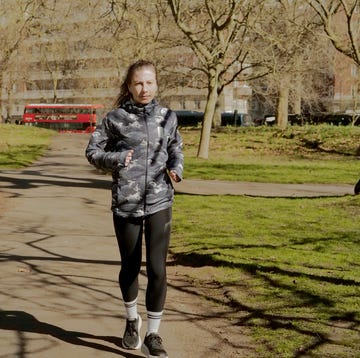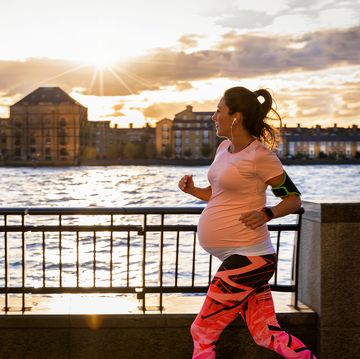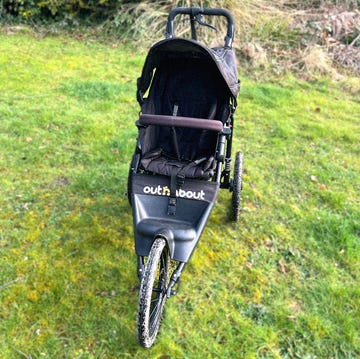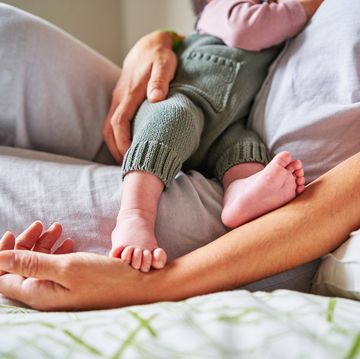Endometriosis is a debilitating condition which is believed to affect around 1.5 million women in the UK - that's around 1 in 10. It can cause chronic pain which can be difficult to manage, particularly since the average diagnosis takes eight years, according to research by Endometriosis UK.
Worldwide, too, around 10% of women have the condition, and in the UK it is the second most common gynaecological condition, after fibroids. Endometriosis is estimated to cost the UK economy £8.2bn a year in treatment, healthcare costs and loss of work.
What is endometriosis?
With endometriosis, cells similar to the ones in the lining of the uterus (the endometrium) grow outside of the uterus on other pelvic organs. Each month these cells react to the menstrual cycle in the same way to those within the womb, building up and then breaking down and bleeding.
What everyone's reading
However, unlike with a 'normal' period, there is no way for this blood to leave the body, and this causes inflammation and the formation of scar tissue. This displaced tissue can lead to severely painful periods, excessive bleeding and infertility.
What are the symptoms?
Endometriosis causes a range of symptoms which can vary from person to person. The most common is severe pelvic pain, especially during menstrual periods. Other sympstoms can also include lack of energy, depression, pain during sex and difficulty getting pregnant - all of which of course cause many problems both in women's personal and professional lives. It is, however, also possible to have endometriosis with no symptoms.
How is endometriosis treated?
There's no cure for endometriosis, however there are a number of treatment options which aim to ease symptoms so the condition does not interfere with your daily life. Treatment options include hormone treatment, to limit or stop the production of oestrogen in the body, as oestrogen encourages endometriosis tissue to grow and shed. Some of the main hormone-based treatments for endometriosis include: the combined oral contraceptive pill and progestogens, including the intrauterine system (IUS), contraceptive injection, contraceptive implant and progestogen-only pill.
Surgery can also be used to remove or destroy areas of endometriosis tissue, which can help improve symptoms. Some of the options are: laparoscopy – the most commonly used technique, where small cuts (incisions) are made in your tummy so the endometriosis tissue can be destroyed or cut out – and hysterectomy.
You can find out more about these treatments on the NHS website. Your gynaecologist will be able discuss the options with you in depth and outline the risks and benefits of each.
Can exercise help?
Unfortunately, there are very few studies on endometriosis and exercise. A review of the available evidence in 2014 noted that 'the data available are inconclusive regarding the benefits of physical exercise as a risk factor for the disease, and no data exists about the potential impact of exercise on the course of the endometriosis'.
Evidence on whether exercise changes or helps manage the pain symptoms is also inconclusive. While some research has shown exercise to relieve pain, other research has actually contradicted these findings and found it had a negative impact, or even worsened symptoms, according to a systematic review published in Obstetrics and Gynaecology.
However, exercise – and specifically running – does in many cases help mitigate some of the other symptoms of endometriosis. 'Running overall can be beneficial as it reduces the inflammatory levels in the body... however this should be undertaken under the guidance of a physio and/or consultant,' says Aisling Freir, musculoskeletal and pelvic health physiotherapist.
Moreover, exercise can help sufferers by improving mood, reducing stress and bolstering mental wellbeing, says Dr Sarah Rollins, consultant in sport, exercise and musculoskeletal medicine at Pure Sports Medicine: 'This is really important in endometriosis because it can be such a debilitating condition'.
What forms of exercise can alleviate symptoms?
Although the evidence of exercise in alleviating endometriosis symptoms remains unclear, anecdotally, women certainly do report it helping with their pain management – and there's a number of physiological reasons which could explain this. Exercise can help to reduce or suppress abdominal inflammation, decrease oestrogen levels and release endorphins, which could help decrease pain and discomfort levels.
'In addition to the positive effects of exercise on physical and mental health, exercise also promotes the release and circulation of chemical messengers in the body with anti-inflammatory and analgesic properties, which may help to reduce the pelvic pain symptoms of endometriosis which are caused by inflammation and an increased sensitivity to painful stimuli,' explains Romanski.
However, it is important to seek medical advice before starting a new exercise routine, particularly if you have overactive pelvic floor muscles - which is common in those with endometriosis.
'Overactive pelvic floor muscles can be a factor contributing to pain. If the pelvic floor muscles are in this state, exercise of any kind may cause an increase in pain. In addition to abdominal pain, other symptoms that may indicate you have an overactive pelvic floor include urinary urgency, urinary frequency, bladder pain, painful intercourse, vulvar discomfort with wearing tight fitting clothing, gastrointestinal pain or discomfort, lower back or hip pain,' says Heather Jeffcoat, president of the Academy of Pelvic Health Physical Therapy and founder of FeminaPT.com.
Can running help?
As physical activity has been shown to reduce oestrogen levels and increase levels of anti-inflammatory substances, running is one form of exercise that could, in theory, help to reduce the pain symptoms of endometriosis.
'Since endometriosis is an oestrogen-dependent disease, running is a natural way to dampen this pathological process and the pain associated with it. Additionally, the endorphin release that occurs with higher intensity exercise also results in a temporary reduction of pain,' explains Jeffcoat.
There are also huge mental health benefits to getting outside to exercise, not to mention the positive social impact, which can be very important for women with endometriosis. The chronic nature of the condition can lead to depression and feelings of isolation, so meeting people with a shared interest can be a valuable tool in itself.
'It can be a chance to meet people who also love running with whom you can build relationships and share problems,' says Rollins. 'These simple things should not be diminished in value. Humans are better together - especially when running'.
There are, however, some caveats. 'For many, running provides great mental and physical benefits by increasing serotonin and endorphin levels that can boost mood, promote healthy sleep habits, and increase one’s overall quality of life,' Romanski explains. 'However, exercise can also increase the release of prostaglandins in the circulation, which is important for healthy blood flow, but can also result in painful uterine contractions which may exacerbate the symptoms of endometriosis in some people.'
This has been the experience for RW reader Marg Jukes. 'I've always found that exercise, particularly running and yoga, help massively with my endo symptoms. There are rare occasions when a run will do the exact opposite and kick off discomfort, which happened to me recently but this doesn't happen often and the benefits of running outweigh the risks so I'll stick with running for as long as I can,' she says.
'For my mental health, running is one of the things that has got me through the last few years, which have been difficult. Having been through two laparoscopies, pregnancy loss and fertility issues, my mental health has been hugely affected. I love to put my headphones on and have a long solo run, but during difficult times I can also rely on the support of my parkrun friends, which has made the worst times that bit easier to cope with.
I'd recommend running to anyone suffering with endometriosis, for both the physical and mental health benefits.'
Anyone who is finding that exercise is exacerbating their symptoms should stop the exercise and seek medical advice.
Targeted strength and conditioning
The key piece of advice for endometriosis sufferers is to listen to your body and explore what works for you. However, Rollins does recommend focusing on strength work in a specific area.
'As endometriosis is predominantly a pelvic pain problem, sometimes also back and hip, it is certainly worth focusing on strength and control around the torso and lumbopelvic region of the trunk, back, pelvis and hips. This will make you a stronger runner regardless of other symptoms, and makes sense even if the written scientific evidence is currently lacking,' she says.
Yoga
Jeffcoat also recommends yoga – she suggests twice a week, for 90 minutes at a time – to reduce pain symptoms. 'Yoga shows benefits with reducing pain through the down regulation – or calming – of the nervous system,' she says.
Certainly a study on the practice of yoga for women with pain-associate endometriosis, published in the Journal of Alternative and Complementary Medicine, found that all participants reported yoga to be beneficial to control pelvic pain. Researchers put this down to increased awareness of the subject's own bodies, and that the women had also identified a relationship between pain management and breathing techniques, which helped to relieve pain.
When should exercise be avoided?
Endometriosis should not prevent women from exercising but there will be times when symptoms limit the ability or desire to be active.
'Because women with endometriosis have such a wide variety of symptoms, exercise may often need to be tailored from person to person, but also from day to day or week to week,' says Rollins.
As with all exercise, knowing when to rest and recover is key, particularly if any new pain occurs. 'Overall it makes sense to dial back the intensity based on your symptoms. It's important to listen to your body and not try to push through,' recommends Amy Roskin, certified obstetrics gynaecologist and chief medical officer at Seven Starling.
For more information on endometriosis visit https://www.endometriosis-uk.org/














